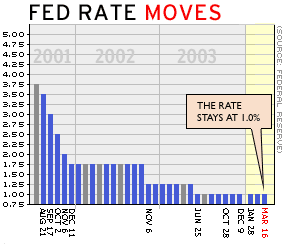NEW YORK (CNN/Money) -
Federal Reserve policy-makers held a key interest rate at the lowest level in more than 40 years Tuesday and again pledged to be "patient" before raising rates.
The central bankers left their target for the federal funds rate at 1 percent, a level last touched in 1962 and not seen on a consistent basis since 1958. The fed funds rate is an overnight bank loan rate that influences many banks' prime lending rates, and it seems likely to stay low for several more months.
"With inflation quite low and resource use slack, the Committee believes that it can be patient in removing its policy accommodation," the Fed said in the closely watched statement accompanying its decision.
Though some economists have called recently for the Fed to prepare investors for an eventual rise in interest rates -- with a few even calling for rate hikes -- Tuesday's decision underscored that the Fed will wait until it sees clear evidence of a labor-market recovery before it budges.

"Nothing about what they said today is surprising -- they changed the minimum number of words (from their last statement)," said David Kelly, senior economist at Putnam Investments. "We're still waiting for confirmation (of a recovery in) the labor market."
In the statement, the Fed altered its view of the job market slightly, saying, "Although job losses have slowed, new hiring has lagged." In the statement after its last meeting in January, it said hiring was "subdued," but that "other indicators suggest an improvement in the labor market."
There was one other difference -- in January, the Fed said economic output was "expanding briskly." In Tuesday's statement, it said output was "continuing to expand at a solid pace."
Otherwise, the two statements were the same, with the Fed saying the risk of inflation remains low, with the "upside" and "downside" risks to sustainable economic growth "roughly equal."
"Those changes were a little softer," said Scott Brown, chief economist at Raymond James & Associates. "It's clear the Fed has to raise rates at some point, but there's no suggestion of that here."
The Fed's unanimous decision to stand pat on its interest-rate target and most of the wording of its policy decision was widely expected by Wall Street economists.
On Wall Street, stock prices rose briefly but then fall back after the decision.
Treasury bond prices reversed early losses and rose, pushing the yield on the 10-year note down to 3.68 percent from 3.78 percent late Monday as bond market investors bet the Fed's rate targets wouldn't be increased anytime soon. Bond yields and prices move in opposite directions.
Weak job market delays rate hike
The Fed lowers its fed funds target when it wants to encourage borrowing and stimulate the economy. It raises the target when it wants to tap the economy's brakes and fend off inflation.
“ I believe the Fed needs to wean the economy off the morphine drip of low interest rates before it gets hooked. ”
David Kelly
Putnam Investments
|
The Fed cut rates repeatedly in 2001, fighting a recession and terror attacks, and added one cut a year in 2002 and 2003 when the economy was still not as robust as policy-makers had hoped.
The super-low fed funds rate has helped keep longer-term rates low despite several quarters of strong economic growth. The sluggish job market and low inflation have also kept rates low.
Expectations that the job market would recover, and inflation would start to pick up, sent investors running into stocks last fall and winter, hurting bond prices and pushing long-term bond market rates higher.
Since then, however, the Labor Department has released several reports of weaker-than-expected job growth, and consumer price inflation -- excluding food and energy -- has been dead in the water, despite a weakening dollar and higher commodity prices.
| Related stories
|

|
|
|
|
Until February's much weaker-than-expected jobs report, some analysts thought the central bank would start raising short-term rates this summer.
Now, many say it won't start raising rates until after the November election, or at least until the Labor Department's survey of payrolls shows several months of strong jobs growth -- a development many economists have been expecting for some time, but which has yet to materialize.
"Until and unless there are significant increases in jobs over a period, tighter monetary policy is out of the question," Sung Won Sohn, chief economist at Wells Fargo, said in a note Tuesday.
The Fed's ever-so-slightly more bearish comments in Tuesday's statement seemed to strengthen that view -- and helped Treasury bond prices rally.
Some economists, however, worry that super-low interest rates could contribute to dangerous price bubbles in stocks, bonds, real estate -- or all three.
In fact, Stephen Roach, influential chief global economist at Morgan Stanley, has called lately for an immediate hike in the fed funds rate to 3 percent.
Few other economists think that would be a good idea, but some do agree that the Fed is playing a dangerous game.
"I believe the Fed needs to wean the economy off the morphine drip of low interest rates before it gets hooked," Putnam's Kelly said.

|